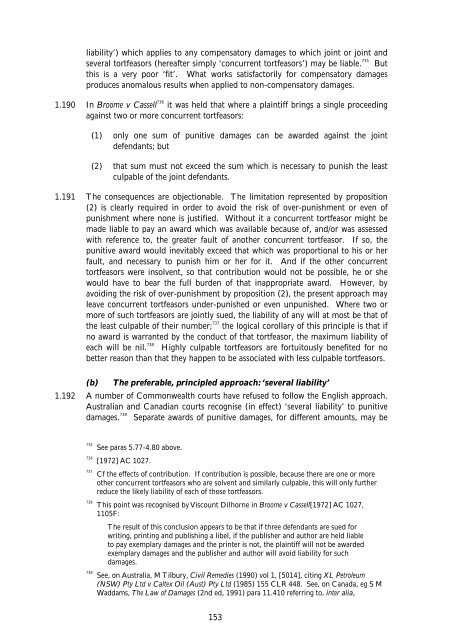Aggravated, Exemplary and Restitutionary ... - Law Commission
Aggravated, Exemplary and Restitutionary ... - Law Commission
Aggravated, Exemplary and Restitutionary ... - Law Commission
Create successful ePaper yourself
Turn your PDF publications into a flip-book with our unique Google optimized e-Paper software.
liability’) which applies to any compensatory damages to which joint or joint <strong>and</strong><br />
several tortfeasors (hereafter simply ‘concurrent tortfeasors’) may be liable. 735<br />
But<br />
this is a very poor ‘fit’. What works satisfactorily for compensatory damages<br />
produces anomalous results when applied to non-compensatory damages.<br />
1.190 In Broome v Cassell 736<br />
it was held that where a plaintiff brings a single proceeding<br />
against two or more concurrent tortfeasors:<br />
(1) only one sum of punitive damages can be awarded against the joint<br />
defendants; but<br />
(2) that sum must not exceed the sum which is necessary to punish the least<br />
culpable of the joint defendants.<br />
1.191 The consequences are objectionable. The limitation represented by proposition<br />
(2) is clearly required in order to avoid the risk of over-punishment or even of<br />
punishment where none is justified. Without it a concurrent tortfeasor might be<br />
made liable to pay an award which was available because of, <strong>and</strong>/or was assessed<br />
with reference to, the greater fault of another concurrent tortfeasor. If so, the<br />
punitive award would inevitably exceed that which was proportional to his or her<br />
fault, <strong>and</strong> necessary to punish him or her for it. And if the other concurrent<br />
tortfeasors were insolvent, so that contribution would not be possible, he or she<br />
would have to bear the full burden of that inappropriate award. However, by<br />
avoiding the risk of over-punishment by proposition (2), the present approach may<br />
leave concurrent tortfeasors under-punished or even unpunished. Where two or<br />
more of such tortfeasors are jointly sued, the liability of any will at most be that of<br />
the least culpable of their number; 737<br />
the logical corollary of this principle is that if<br />
no award is warranted by the conduct of that tortfeasor, the maximum liability of<br />
each will be nil. 738<br />
Highly culpable tortfeasors are fortuitously benefited for no<br />
better reason than that they happen to be associated with less culpable tortfeasors.<br />
(b) The preferable, principled approach: ‘several liability’<br />
1.192 A number of Commonwealth courts have refused to follow the English approach.<br />
Australian <strong>and</strong> Canadian courts recognise (in effect) ‘several liability’ to punitive<br />
damages. 739<br />
Separate awards of punitive damages, for different amounts, may be<br />
735 See paras 5.77-4.80 above.<br />
736 [1972] AC 1027.<br />
737 Cf the effects of contribution. If contribution is possible, because there are one or more<br />
other concurrent tortfeasors who are solvent <strong>and</strong> similarly culpable, this will only further<br />
reduce the likely liability of each of those tortfeasors.<br />
738 This point was recognised by Viscount Dilhorne in Broome v Cassell[1972] AC 1027,<br />
1105F:<br />
The result of this conclusion appears to be that if three defendants are sued for<br />
writing, printing <strong>and</strong> publishing a libel, if the publisher <strong>and</strong> author are held liable<br />
to pay exemplary damages <strong>and</strong> the printer is not, the plaintiff will not be awarded<br />
exemplary damages <strong>and</strong> the publisher <strong>and</strong> author will avoid liability for such<br />
damages.<br />
739 See, on Australia, M Tilbury, Civil Remedies (1990) vol 1, [5014], citing XL Petroleum<br />
(NSW) Pty Ltd v Caltex Oil (Aust) Pty Ltd (1985) 155 CLR 448. See, on Canada, eg S M<br />
Waddams, The <strong>Law</strong> of Damages (2nd ed, 1991) para 11.410 referring to, inter alia,<br />
153
















